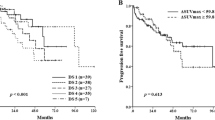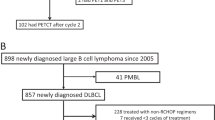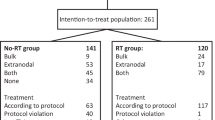Abstract
We examined the role of fluorodeoxyglucose-positron emission tomography (FDG-PET) and the addition of involved field radiotherapy (IFRT) as potential modifiers of salvage therapy. From January 2000 to June 2007, 83 patients with chemosensitive relapsed or primary refractory diffuse large B-cell lymphoma (DLBCL) underwent FDG-PET scans following second-line chemotherapy before high-dose therapy with autologous stem cell rescue (HDT/ASCR). We evaluated the prognostic value of having a negative FDG-PET scan before HDT/ASCR and whether IFRT improved the outcomes. Median follow-up was 45 months, and the 3-year PFS, disease-specific survival (DSS) and OS were 72, 80 and 78%, respectively. Multivariate analysis revealed that a positive FDG-PET scan had worse PFS (hazard ratio=(HR) 3.4; P=0.014), DSS (HR=7.7; P=0.001) and OS (HR=5.4; P=0.001), and that patients not receiving IFRT had worse PFS (HR=2.7; P=0.03) and DSS (HR=2.8, P=0.059). Patients who received IFRT had better local control with fewer relapses within prior involved sites compared with those that did not receive IFRT (P=0.006). These outcomes confirm the important prognostic value of FDG-PET scans before undergoing HDT/ASCR. It also suggests that the role of IFRT should be evaluated further.
This is a preview of subscription content, access via your institution
Access options
Subscribe to this journal
Receive 12 print issues and online access
$259.00 per year
only $21.58 per issue
Buy this article
- Purchase on Springer Link
- Instant access to full article PDF
Prices may be subject to local taxes which are calculated during checkout



Similar content being viewed by others
References
Barrington SF, Carr R . Staging of Burkitt's lymphoma and response to treatment monitored by PET scanning. Clin Oncol (R Coll Radiol) 1995; 7: 334–335.
Freudenberg LS, Antoch G, Schutt P, Beyer T, Jentzen W, Muller SP et al. FDG-PET/CT in re-staging of patients with lymphoma. Eur J Nucl Med Mol Imaging 2004; 31: 325–329.
Moog F, Bangerter M, Diederichs CG, Guhlmann A, Kotzerke J, Merkle E et al. Lymphoma: role of whole-body 2-deoxy-2-[F-18]fluoro-D-glucose (FDG) PET in nodal staging. Radiology 1997; 203: 795–800.
Schaefer NG, Hany TF, Taverna C, Seifert B, Stumpe KD, von Schulthess GK et al. Non-Hodgkin lymphoma and Hodgkin disease: coregistered FDG PET and CT at staging and restaging—do we need contrast-enhanced CT? Radiology 2004; 232: 823–829.
Schoder H, Meta J, Yap C, Ariannejad M, Rao J, Phelps ME et al. Effect of whole-body (18)F-FDG PET imaging on clinical staging and management of patients with malignant lymphoma. J Nucl Med 2001; 42: 1139–1143.
Becherer A, Mitterbauer M, Jaeger U, Kalhs P, Greinix HT, Karanikas G et al. Positron emission tomography with [18F]2-fluoro-D-2-deoxyglucose (FDG-PET) predicts relapse of malignant lymphoma after high-dose therapy with stem cell transplantation. Leukemia 2002; 16: 260–267.
Cremerius U, Fabry U, Wildberger JE, Zimny M, Reinartz P, Nowak B et al. Pre-transplant positron emission tomography (PET) using fluorine-18-fluoro-deoxyglucose (FDG) predicts outcome in patients treated with high-dose chemotherapy and autologous stem cell transplantation for non-Hodgkin's lymphoma. Bone Marrow Transplant 2002; 30: 103–111.
Filmont JE, Czernin J, Yap C, Silverman DH, Quon A, Phelps ME et al. Value of F-18 fluorodeoxyglucose positron emission tomography for predicting the clinical outcome of patients with aggressive lymphoma prior to and after autologous stem-cell transplantation. Chest 2003; 124: 608–613.
Filmont JE, Gisselbrecht C, Cuenca X, Deville L, Ertault M, Brice P et al. The impact of pre- and post-transplantation positron emission tomography using 18-fluorodeoxyglucose on poor-prognosis lymphoma patients undergoing autologous stem cell transplantation. Cancer 2007; 110: 1361–1369.
Kasamon YL, Wahl RL, Swinnen LJ . FDG PET and high-dose therapy for aggressive lymphomas: toward a risk-adapted strategy. Curr Opin Oncol 2004; 16: 100–105.
Schot B, van Imhoff G, Pruim J, Sluiter W, Vaalburg W, Vellenga E . Predictive value of early 18F-fluoro-deoxyglucose positron emission tomography in chemosensitive relapsed lymphoma. Br J Haematol 2003; 123: 282–287.
Schot BW, Zijlstra JM, Sluiter WJ, van Imhoff GW, Pruim J, Vaalburg W et al. Early FDG-PET assessment in combination with clinical risk scores determines prognosis in recurring lymphoma. Blood 2007; 109: 486–491.
Spaepen K, Stroobants S, Dupont P, Vandenberghe P, Maertens J, Bormans G et al. Prognostic value of pretransplantation positron emission tomography using fluorine 18-fluorodeoxyglucose in patients with aggressive lymphoma treated with high-dose chemotherapy and stem cell transplantation. Blood 2003; 102: 53–59.
Svoboda J, Andreadis C, Elstrom R, Chong EA, Downs LH, Berkowitz A et al. Prognostic value of FDG-PET scan imaging in lymphoma patients undergoing autologous stem cell transplantation. Bone Marrow Transplant 2006; 38: 211–216.
Chadha M, Shank B, Fuks Z, Clarkson BD, Bonfiglio P, Gnecco C et al. Improved survival of poor prognosis diffuse histiocytic (large cell) lymphoma managed with sequential induction chemotherapy, ‘boost’ radiation therapy, and autologous bone marrow transplantation. Int J Radiat Oncol Biol Phys 1988; 14: 407–415.
Hoppe BS, Moskowitz CH, Filippa DA, Moskowitz CS, Kewalramani T, Zelenet AD et al. Involved-field radiotherapy before high-dose therapy and autologous stem-cell rescue in diffuse large-cell lymphoma: long-term disease control and toxicity. J Clin Oncol 2008; 26: 1858–1864.
Delbeke D, Rose D, Chapman W, Pinson C, Wright J, Beauchamp R et al. Optimal interpretation of FDG-PET in the diagnosis, staging and management of pancreatic carcinoma. J Nucl Med 1999; 40: 1784–1791.
Tian J, Chen L, Wei B, Shao M, Ding Y, Yin D et al. The value of vesicant 18F-fluorodeoxyglucose positron emission tomography in gastric malignancies. Nucl Med Commun 2004; 25: 825–831.
Naumann R, Vaic A, Beuthien-Baumann B, Bredow J, Kropp J, Kittner T et al. Prognostic value of positron emission tomography in the evaluation of post-treatment residual mass in patients with Hodgkin's disease and non-Hodgkin's lymphoma. Br J Haematol 2001; 115: 793–800.
Kaplan EL, Meier P . Nonparametric estimation from incomplete observations. J Am Stat Assoc 1958; 53: 457–481.
Mantel N . Evaluation of survival data and two new rank order statistics arising in its consideration. Cancer Chemother Rep 1966; 50: 163–170.
Cox D . Regression models and life-tables. J R Stat Soc 1972; 34: 187–220.
Philip T, Guglielmi C, Hagenbeek A, Somers R, Van der Lelie H, Bron D et al. Autologous bone marrow transplantation as compared with salvage chemotherapy in relapses of chemotherapy-sensitive non-Hodgkin's lymphoma. N Engl J Med 1995; 333: 1540–1545.
Zelenetz AD, Advani RH, Buadi F, Cabanillas F, Caligiuri MA, Czuczman MS et al. Non-Hodgkin's lymphoma. Clinical practice guidelines in oncology. J Natl Compr Canc Netw 2006; 4: 258–310.
Cheson BD, Pfistner B, Juweid ME, Gascoyne RD, Specht L, Horning SJ et al. Revised response criteria for malignant lymphoma. J Clin Oncol 2007; 25: 579–586.
Philip T, Armitage JO, Spitzer G, Chauvin F, Jagannath S, Cahn JY et al. High-dose therapy and autologous bone marrow transplantation after failure of conventional chemotherapy in adults with intermediate-grade or high-grade non-Hodgkin′s lymphoma. N Engl J Med 1987; 316: 1493–1498.
Takvorian T, Canellos GP, Ritz J, Freedman AS, Anderson KC, Mauch P et al. Prolonged disease-free survival after autologous bone marrow transplantation in patients with non-Hodgkin's lymphoma with a poor prognosis. N Engl J Med 1987; 316: 1499–1505.
Kahn ST, Flowers CR, Lechowicz MJ, Hollenbach K, Johnstone PA . Refractory or relapsed Hodgkin′s disease and non-Hodgkin′s lymphoma: optimizing involved-field radiotherapy in transplant patients. Cancer J 2005; 11: 425–431.
Oehler-Janne C, Taverna C, Stanek N, Negretti L, Lutolf UM, Ciernik IF . Consolidative involved field radiotherapy after high dose chemotherapy and autologous stem cell transplantation for non-Hodgkin's lymphoma: a case-control study. Hematol Oncol 2008; 26: 82–90.
Rapoport AP, Lifton R, Constine LS, Duerst RE, Abboud CN, Liesveld JL et al. Autotransplantation for relapsed or refractory non-Hodgkin′s lymphoma (NHL): long-term follow-up and analysis of prognostic factors. Bone Marrow Transplant 1997; 19: 883–890.
Rodriguez J, Caballero MD, Gutierrez A, Solano C, Arranz R, Lahuerta JJ et al. Autologous stem-cell transplantation in diffuse large B-cell non-Hodgkin's lymphoma not achieving complete response after induction chemotherapy: the GEL/TAMO experience. Ann Oncol 2004; 15: 1504–1509.
Vose JM, Zhang MJ, Rowlings PA, Lazarus HM, Bolwell BJ, Freytes CO et al. Autologous transplantation for diffuse aggressive non-Hodgkin's lymphoma in patients never achieving remission: a report from the Autologous Blood and Marrow Transplant Registry. J Clin Oncol 2001; 19: 406–413.
Acknowledgements
This study was supported from the Lymphoma Foundation and the Sports Foundation against Cancer. BSH, MD, was a Dr Mortimer Lacher 2007 Lymphoma Fellow at the Memorial Sloan-Kettering Cancer Center. We thank Carol Pearce, MFA, writer/editor with the MSKCC Department of Medicine Editorial Unit, for reviewing this manuscript.
Author information
Authors and Affiliations
Consortia
Corresponding author
Additional information
Presented at the American Society for Hematology (ASH) 2007 meeting in Atlanta, GA and American Society for Therapeutic Radiology and Oncology (ASTRO) 2008 meeting in Boston, MA, USA.
Rights and permissions
About this article
Cite this article
Hoppe, B., Moskowitz, C., Zhang, Z. et al. The role of FDG-PET imaging and involved field radiotherapy in relapsed or refractory diffuse large B-cell lymphoma. Bone Marrow Transplant 43, 941–948 (2009). https://doi.org/10.1038/bmt.2008.408
Received:
Revised:
Accepted:
Published:
Issue Date:
DOI: https://doi.org/10.1038/bmt.2008.408
Keywords
This article is cited by
-
Hypofractionated radiotherapy for refractory or relapsed aggressive B-cell lymphoma in the rituximab era
BMC Cancer (2024)
-
Radiation and Chimeric Antigen Receptor T-cell Therapy in B-cell Non-Hodgkin Lymphomas
Current Treatment Options in Oncology (2022)
-
Long-term remissions in patients with early relapse of diffuse large B-cell lymphoma following high-dose chemotherapy, autologous stem cell transplantation, and radiotherapy of residual disease
Strahlentherapie und Onkologie (2022)
-
The value of complete remission according to positron emission tomography prior to autologous stem cell transplantation in lymphoma: a population-based study showing improved outcome
BMC Cancer (2021)
-
Evolution of lymphoma staging and response evaluation: current limitations and future directions
Nature Reviews Clinical Oncology (2017)



